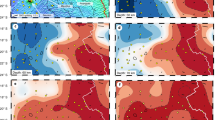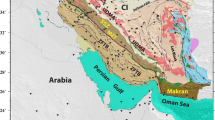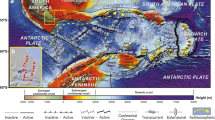Abstract
Tectonic plates are underlain by a low-viscosity mantle layer, the asthenosphere. Asthenospheric flow may be induced by the overriding plate or by deeper mantle convection1. Shear strain due to this flow can be inferred using the directional dependence of seismic wave speeds—seismic anisotropy. However, isolation of asthenospheric signals is challenging; most seismometers are located on continents, whose complex structure influences the seismic waves en route to the surface. The Cascadia Initiative, an offshore seismometer deployment in the US Pacific Northwest, offers the opportunity to analyse seismic data recorded on simpler oceanic lithosphere2. Here we use measurements of seismic anisotropy across the Juan de Fuca and Gorda plates to reconstruct patterns of asthenospheric mantle shear flow from the Juan de Fuca mid-ocean ridge to the Cascadia subduction zone trench. We find that the direction of fastest seismic wave motion rotates with increasing distance from the mid-ocean ridge to become aligned with the direction of motion of the Juan de Fuca Plate, implying that this plate influences mantle flow. In contrast, asthenospheric mantle flow beneath the Gorda Plate does not align with Gorda Plate motion and instead aligns with the neighbouring Pacific Plate motion. These results show that asthenospheric flow beneath the small, slow-moving Gorda Plate is controlled largely by advection due to the much larger, faster-moving Pacific Plate.
This is a preview of subscription content, access via your institution
Access options
Subscribe to this journal
Receive 12 print issues and online access
$259.00 per year
only $21.58 per issue
Buy this article
- Purchase on Springer Link
- Instant access to full article PDF
Prices may be subject to local taxes which are calculated during checkout



Similar content being viewed by others
References
Conrad, C., Behn, M. & Silver, P. Global mantle flow and the development of seismic anisotropy: Differences between the oceanic and continental upper mantle. J. Geophys. Res. 112, B07317 (2007).
Toomey, D. et al. The Cascadia initiative: A sea change in seismological studies of subduction zones. Oceanography 27, 138–150 (2014).
Riddihough, R. Recent movements of the Juan de Fuca plate system. J. Geophys. Res. 89, 6980–6994 (1984).
Eakin, C. et al. Seismic anisotropy beneath Cascadia and the Mendocino triple junction: Interaction of the subducting slab with mantle flow. Earth Planet Sci. Lett. 297, 627–632 (2010).
Currie, C. et al. Shear wave anisotropy beneath the Cascadia subduction zone and western North American craton. Geophys. J. Int. 157, 341–353 (2004).
Long, M. & Silver, P. The subduction zone flow field from seismic anisotropy: A global view. Science 319, 315–318 (2008).
Silver, G. & Chan, W. Shear wave splitting and subcontinental mantle deformation. J. Geophys. Res. 96, 16429–16454 (1991).
Nicolas, A. & Christensen, N. in Composition, Structure and Dynamics of the Lithosphere-Asthenosphere System (eds Fuchs, K. & Froidevaux, C.) 111–123 (Geodynamics Series 16, American Geophysical Union, 1987).
Karato, S., Katayama, I. & Skemer, P. Geodynamic significance of seismic anisotropy of the upper mantle: New insights from laboratory studies. Ann. Rev. Earth Planet. Sci. 36, 59–95 (2008).
Song, T. & Kawakatsu, H. Subduction of oceanic asthenosphere: Evidence from sub-slab seismic anisotropy. Geophys. Res. Lett. 39, L17301 (2012).
Heesemann, M. et al. Ocean Networks Canada: From geohazards research laboratories to Smart Ocean Systems. Oceanography 27, 151–153 (2014).
Bell, S., Forsyth, D. & Ruan, Y. Removing noise from the vertical component records of ocean-bottom seismometers: Results from year one of the Cascadia Initiative. Bull. Seismol. Soc. Am. 105, 300–313 (2014).
Webb, S. Broadband seismology and noise under the ocean. Rev. Geophys. 36, 105–142 (1998).
Lodewyk, J. & Sumy, D. Cascadia Amphibious Array Ocean Bottom Seismograph Horizontal Component Orientations (OBSIP Management Office, 2014); http://www.obsip.org/experiments/experiment-list/2011/cascadia.
Wolfe, C. & Solomon, S. Shear-wave splitting and implications for mantle flow beneath the MELT region of the East Pacific Rise. Science 280, 1230–1232 (1998).
Fontaine, F. et al. Upper-mantle flow beneath French Polynesia from shear wave splitting. Geophys. J. Int. 170, 1262–1288 (2007).
Zandt, G. & Humphreys, E. Toroidal mantle flow through the western US slab window. Geology 36, 295–298 (2008).
Obrebski, M. et al. Slab-plume interaction beneath the Pacific Northwest. Geophys. Res. Lett. 37, L14305 (2010).
Nishimura, C. & Forsyth, D. The anisotropic structure of the upper mantle in the Pacific. Geophys. J. Int. 96, 203–229 (1989).
Kendall, J. et al. Magma-assisted rifting in Ethiopia. Nature 433, 146–148 (2005).
Blackman, D. & Kendall, J. Sensitivity of teleseismic body waves to mineral texture and melt in the mantle beneath a mid-ocean ridge. Phil. Trans. R. Soc. Lond. A. 355, 217–231 (1997).
Gripp, A. & Gordon, R. Young tracks of hotspots and current plate velocities. Geophys. J. Int. 150, 321–361 (2002).
Debayle, E. & Ricard, Y. Seismic observations of large-scale deformation at the bottom of fast-moving plates. Earth Planet. Sci. Lett. 376, 165–177 (2013).
Chaytor, J. et al. Active deformation of the Gorda plate: Constraining deformation models with new geophysical data. Geology 32, 353–356 (2004).
Hager, B. H. & O’Connell, R. J. A simple global model of plate dynamics and mantle convection. J. Geophys. Res. 86, 4843–4867 (1981).
Fjeldskaar, W. Viscosity and thickness of the asthenosphere detected from the Fennoscandian uplift. Earth Planet. Sci. Lett. 126, 399–410 (1994).
Wessel, P. & Smith, W. New, improved version of Generic Mapping Tools released. EOS Trans. Am. Geophys. Union 79, 579 (1998).
Wüstefeld, A. et al. Identifying global seismic anisotropy patterns by correlating shear-wave splitting and surface-wave data. Phys. Earth Planet. Int. 176, 198–212 (2009).
Porritt, R., Allen, R. & Pollitz, F. Seismic imaging east of the Rocky Mountains with USArray. Earth Planet. Sci. Lett. 402, 16–25 (2014).
Hayes, G., Wald, D. & Johnson, R. Slab1.0: A three-dimensional model of global subduction zone geometries. J. Geophys. Res. 117, B01302 (2012).
Wüstefeld, A. et al. SplitLab: A shear-wave splitting environment in Matlab. Comp. Geosci. 34, 515–528 (2008).
Wüstefeld, A. et al. A strategy for automated analysis of passive microseismic data to image seismic anisotropy and fracture characteristics. Geophys. Prospect. 58, 755–773 (2010).
Bowman, J. & Ando, M. Shear-wave splitting in the upper-mantle wedge above the Tonga subduction zone. Geophys. J. Int. 88, 25–41 (1987).
Wüstefeld, A. & Bokelmann, G. Null detection in shear-wave splitting measurements. Bull. Seism. Soc. Am. 97, 1204–1211 (2007).
Wolfe, C. & Silver, P. Seismic anisotropy of oceanic upper mantle: Shear wave splitting methodologies and observations. J. Geophys. Res. 103, 749–771 (1998).
Stachnik, J. et al. Determination of New Zealand ocean bottom seismometer orientation via Rayleigh-wave polarization. Seism. Res. Lett. 83, 704–713 (2012).
Tian, X. et al. SKS splitting measurements with horizontal component misalignment. Geophys. J. Int. 185, 329–340 (2011).
Richards, M. et al. Role of a low-viscosity zone in stabilizing plate tectonics: Implications for comparative terrestrial planetology. Geochem. Geophys. Geosyst. 2, 1026 (2001).
Nettles, M. & Dziewński, A. Radially anisotropic shear velocity structure of the upper mantle globally and beneath North America. Geophys. J. Int. 113, B02303 (2008).
Paulson, A. & Richards, M. On the resolution of radial viscosity structure in modeling long-wavelength postglacial rebound data. Geophys. J. Int. 179, 1516–1526 (2009).
Acknowledgements
Support for this work was provided by the National Science Foundation (OCE-1139701) to R.M.-S. and R.M.A. The data used in this research were provided by instruments from the Ocean Bottom Seismograph Instrument Pool (http://www.obsip.org), which is funded by the National Science Foundation under cooperative agreement OCE-1112722. The work benefited from discussions with J. Lodewyk, A. Frassetto and C. Eakin. GMT (Wessel and Smith27) and MATLAB were used to create the figures.
Author information
Authors and Affiliations
Contributions
This study was carried out and written up by R.M.-S., under supervision of R.M.A. I.D.B. assisted with data analysis and helped write the paper. E.T. and M.A.R. provided advice and minor modifications to the text.
Corresponding author
Ethics declarations
Competing interests
The authors declare no competing financial interests.
Supplementary information
Supplementary Information
Supplementary Information (PDF 12646 kb)
Rights and permissions
About this article
Cite this article
Martin-Short, R., Allen, R., Bastow, I. et al. Mantle flow geometry from ridge to trench beneath the Gorda–Juan de Fuca plate system. Nature Geosci 8, 965–968 (2015). https://doi.org/10.1038/ngeo2569
Received:
Accepted:
Published:
Issue Date:
DOI: https://doi.org/10.1038/ngeo2569
This article is cited by
-
Large-scale flow of Indian Ocean asthenosphere driven by Réunion plume
Nature Geoscience (2019)
-
Bridging the connection between effective viscosity and electrical conductivity through water content in the upper mantle
Scientific Reports (2018)
-
Go with the flow
Nature Geoscience (2015)



